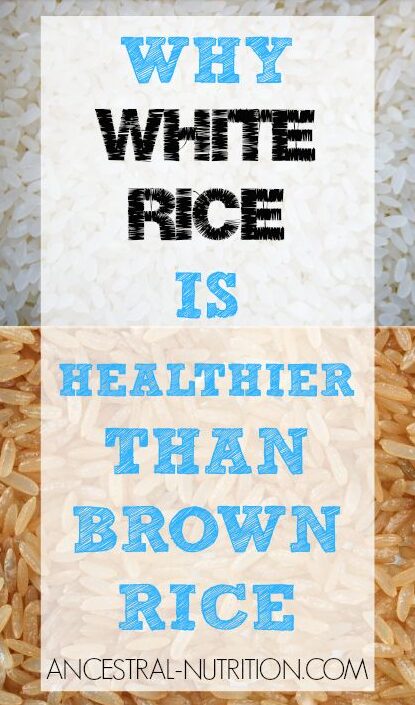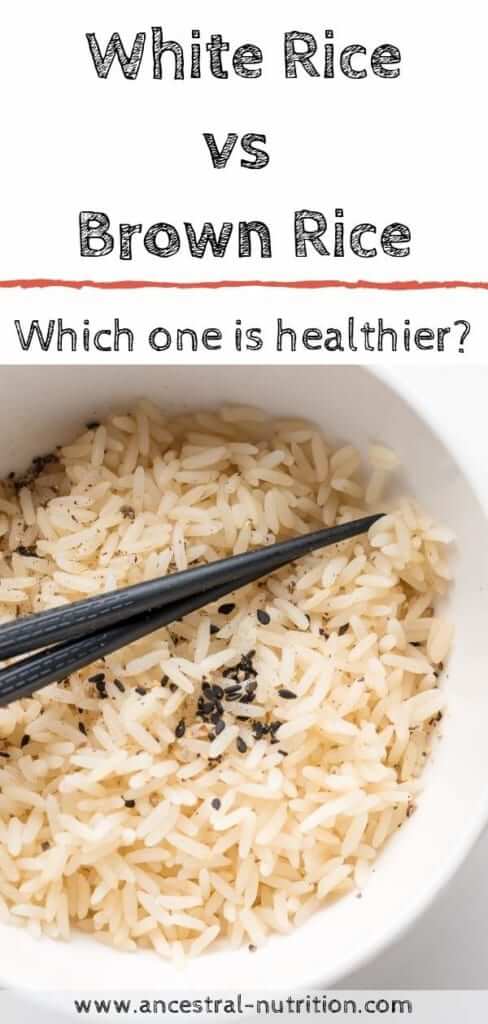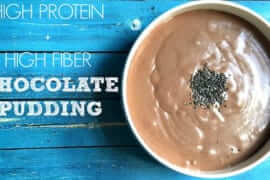Brown Rice vs White Rice – which rice is best for you? While brown rice is often recognized as the healthier option, this article presents the benefits of eating white rice!
Truth be told, I really dislike labels, especially when it comes to diet. I don’t like being pigeonholed into one specific category, and having to follow the guidelines of what is expected and outlined within that categorization. I’m a free spirit, I follow no rules!
Which is why it’s kind of frustrating to constantly be asked about my white rice consumption. I feel we need to talk brown rice vs white rice!
Brown Rice vs White Rice – Which rice is best for you?
Let’s start with some frequently asked questions that I get to hear a lot. Like a lot lot.
Isn’t white rice bad? Won’t it spike your blood sugar? Isn’t brown rice healthier than white rice?
The answer to all of these questions is a resounding NO.
And we have to include my favorite question: Is rice paleo?!
I advocate eating what your ancestors ate, whether that’s 100,00 years ago or 100 years ago is up to you. There is huge power in ancestral knowledge.
These people knew (without needing doctors or studies to tell them) which foods were healthy, they knew that a pregnant woman or growing child needed nutrient-dense animal fats, they knew there was value in the whole animal, organs and all, not just the muscle meat, they knew to make broth from the bones, which is one of the most healing foods on earth.
And they knew to eat white rice.

Have you ever wondered why Asian countries have eaten white rice for thousands of years, not brown?
Because brown rice is full of phytates and lectins, which bind to vitamins and minerals and prevent them from being absorbed.
Here’s an excerpt from my upcoming ebook (which you should totally join my mailing list to get updates about it. It’s going to be awesome):
Phytates are anti-nutrients found in grains and legumes. Phytates, or phytic acid, binds to minerals like zinc, copper, iron, magnesium, niacin and calcium, preventing them from being absorbed.
Phytic acid also inhibits pepsin, the enzyme needed to properly break down protein as well as amylase, the enzyme needed to break down sugar. So not only does phytic acid prevent nutrient absorption, it interferes with proper digestion.
But isn’t brown rice more nutrient dense than white?
No. And let me be clear: I don’t eat rice because of its nutrient profile. Rice, in general, a good source of vitamins or minerals. Rice is an easily absorbable form of glucose, which is why I usually eat it after a workout.
While brown rice is slightly higher on the vitamin and mineral front, you have to consider that it is loaded with phytates, meaning these vitamins and minerals are not being absorbed.
Here is the nutrient profile for brown rice vs white rice:
| White Rice (100 g) | Brown Rice (100 g) | |
| Calcium | 3 | 10 |
| Iron | 1.49 | 0.53 |
| Magnesium | 13 | 44 |
| Phosphorous | 37 | 77 |
| Potassium | 29 | 79 |
| Zinc | 0.42 | 0.62 |
| Thiamin | 0.167 | 0.102 |
| Riboflavin | 0.016 | 0.012 |
| Niacin | 1.835 | 1.330 |
| Vitamin B6 | 0.050 | 0.149 |
| Folate | 97 | 4 |
| Vitamin B12 | 0 | 0 |
| Vitamin A | 0 | 0 |
| Vitamin D | 0 | 0 |
| Vitamin K | 0 | 0 |
Not so nutrient dense, huh? Now, compare that to the nutrition in an egg:
| Egg (100 g) | |
| Calcium | 66 |
| Iron | 1.31 |
| Magnesium | 11 |
| Phosphorous | 165 |
| Potassium | 132 |
| Zinc | 1.04 |
| Thiamin | 0.040 |
| Riboflavin | 0.376 |
| Niacin | 36 |
| Folate | 0.134 |
| Vitamin B6 | 0.143 |
| Vitamin B12 | 0.76 |
| Vitamin A | 161 |
| Vitamin D | 72 |
| Vitamin K | 4 |
Another valid point in the whole brown rice vs white rice discussion: Both the bran and germ are still intact in brown rice. This makes brown rice much harder to digest. Because the bran and germ can be so irritating to the digestive tract, it can also lead to leaky gut syndrome, especially if eaten on a regular basis (and in combination with other grains).
Leaky gut is partially caused and definitely aggravated by grains like brown rice; the grain essentially tears the lining of the gut, allowing undigested food particles, toxins, bacteria, etc. to enter the bloodstream. This leads to allergies, mental disorders, autoimmune diseases and so much more.
Brown Rice vs White Rice – Conclusion, aka: So, is white rice healthy?
White rice is an easily absorbable form of glucose that is easy to digest, therefore making it a safe starch.
I don’t recommend grains of any kind for someone with leaky gut, blood sugar issues or an autoimmune disorder, but for most people white rice is fine.
Personally, I like to eat white rice after a workout to replace my glycogen levels. And make sure to eat it with fat and/or vinegar, this will cut the glycemic index in half, ensuring that your blood sugar doesn’t spike.
If you are sensitive to starches or find that you normally do not react well to them and would like to try white rice, start with a small amount and see how your body reacts. Everybody’s different.
*I recommend THIS brand of rice; they are all organic and only use sustainable and healthy methods to grow and produce their rice.

Sources for this Brown Rice vs White rice article:
EDITED 9/20/2017: this post is old and the links are now outdated. Here are updated figures for the nutritional content of white and brown rice; while the figures are not the same they are similar and still prove various points made in the article:
http://nutritiondata.self.com/facts/cereal-grains-and-pasta/5815/2
http://nutritiondata.self.com/facts/cereal-grains-and-pasta/5707/2






